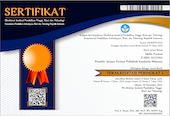PROFIL KROMATOGRAFI LAPIS TIPIS EKSTRAK KUNYIT (Curcuma longa Linn) SEGAR DAN SIMPLISIA DENGAN VARIASI METODE EKSTRAKSI
Abstract
Turmeric is a rhizome plant used as traditional Indonesian medicine. Generally, the extraction process influences the efficacy of turmeric in curing a disease. This study compares the thin layer chromatography profile (TLC) of turmeric extract based on variations in the extraction method. The extraction process was carried out using 70% ethanol solvent in fresh rhizomes and turmeric simplicia. The study used maceration, sonication, and microwave assistance techniques. The thin layer chromatography profiles were analyzed using curcuminoid standards in visible and UV light visualization (254 and 366 nm). The results showed higher yields in the fresh turmeric extracts through maceration extraction, sonication, and microwave-assisted techniques, respectively. The thin layer chromatography pattern using eluent chloroform dichloromethane (32.5: 67.5 v / v) showed the extract was separated into 3 - 4 compounds, with different curcuminoid thicknesses in each treatment. The thin layer chromatography profile with the highest quality of curcuminoid content was found successively in sonication simplicia, maceration, and microwave simplicia extracts, as well as sonication fresh turmeric extract, maceration, and microwaves. The high yield of turmeric extract does not indicate an increase in the quality of the curcuminoid levels produced.
Keywords: Turmeric, Thin Layer Chromatography, curcuminoids, extraction modification
Kunyit merupakan tanaman rhizoma yang telah dimanfaatkan dalam pengobatan tradisional Indonesia. Khasiat kunyit dalam menyembuhkan suatu penyakit dipengaruhi oleh proses ekstraksinya. Penelitian ini bertujuan membandingkan profil kromatografi lapis tipis (KLT) ekstrak kunyit berdasarkan variasi metode ekstraksi. Proses ekstraksi dilakukan menggunakan pelarut etanol 70% pada rimpang segar dan simplisia kunyit. Teknik ekstraksi yang dilakukan adalah secara maserasi, sonikasi dan bantuan gelombang mikro. Profil kromatografi lapis tipis dianalisis dengan menggunakan standar kurkuminoid pada visualisasi sinar tampak serta UV (254 dan 366 nm). Hasil penelitian menunjukkan rendemen yang lebih tinggi terdapat pada jenis ekstrak kunyit segar daripada simplisianya, secara berturut-turut melalui teknik ekstraksi maserasi, sonikasi, dan bantuan gelombang mikro. Pola kromatografi lapis tipis ekstrak dengan menggunakan eluen kloroform:diklorometan (32,5:67,5 v/v) menunjukkan bahwa ekstrak terpisah menjadi 3 - 4 senyawa, dengan ketebalan kurkuminoid yang berbeda pada masing-masing perlakuan ekstraksi. Profil kromatografi lapis tipis dengan kualitas kadar kurkuminoid tertinggi terdapat pada ekstrak simplisia secara sonikasi, disusul dengan ekstrak simplisia secara maserasi dan gelombang mikro, serta ekstrak kunyit segar secara sonikasi, maserasi, dan gelombang mikro. Rendemen yang tinggi dari ekstrak kunyit tidak mengindikasikan kualitas kadar kurkuminoid yang dihasilkan semakin baik.
Kata kunci: Kunyit, Kromatografi Lapis Tipis, kurkuminoid, modifikasi ekstraksi
Full Text:
PDF (Bahasa Indonesia)References
Azmir J., Zaidul I.S.M., Rahman M.M., Sharif K.M., Mohamed A., Sahena F., Jahurul M.H.A., Ghafoor K., Norulaini N.A.N., Omar A.K.M. 2013. Techniques for extraction of bioactive compounds from plant materials: A review. Journal of Food Engineering Volume 117, Issue 4.
Azwanida N.N. 2015. A Review on the Extraction Methods Use in Medicinal Plants, Principle,Strength and Limitation. Med Aromat Plants 4:3.
[BPOM] Badan Pengawas Obat dan Makanan. 2004. Monografi Ekstrak Tumbuhan Obat Indonesia. Volume 1. Jakarta: BPOM RI.
Chemat F., Rombaut N., Sicaire A.G., Meullemiestre A., Tixier A.S.F., Vian M.A. 2017. Ultrasound assisted extraction of food and natural products. Mechanisms, techniques, combinations, protocols and applications. A review. Ultrasonics Sonochemistry (34): 540-560.
Kalaycioglu Z., Gazioglu I., Erim F.B. 2017. Comparison of antioxidant, anticholinesterase, and antidiabetic activities of three curcuminoids isolated from Curcuma longa L. Natural Product Research. Vol. 31, No. 24, 2914–2917.
Lal J. 2012. Turmeric, Curcumin and Our Life: A Review. Bulletin of Environment, Pharmacology and Life Sciences. Volume 1 [7] June 2012: 11- 17.
Purwakusumah ED, Royani L, Rafi M. 2016. Evaluasi Aktivitas Antioksidan dan Perubahan Metabolit Sekunder Mayor Temulawak (Curcuma xanthorriza) Pada Umur Rimpang Yang Berbeda. Jurnal Jamu Indonesia 1(1):10-17.
Rafi M, Rohaeti E, Miftahudin A, Darusman LK. 2011. Differentiation of Curcuma longa, Curcuma xanthorrhiza and Zingiber cassumunar by thin layer chromatography fingerprint analysis. Indo J Chem 11(1):71-74.
Rouhani S, Alizadeh N, Salimi Sh, Ghasemi TH. 2009. Ultrasonic assisted extraction of natural pigments from rhizomes of Curcuma Longa L. J.Prog. Color Colorants Coat.2: 103 – 113.
Sa’ad A., Fajar D.R., Alawiyah T., 2019. Kandungan Rhodamin B Pada Sediaan Lip Tint Yang Digunakan Mahasiswi STIKes Pelamonia. Media Farmasi (15): 125-131.
Sherma J., Rabel F. 2018. A review of thin layer chromatography methods for determination of authenticity of foods and dietary supplements. Journal of Liquid Chromatography & Related Technologies. DOI: 10.1080/10826076.2018.1505637.
Winarto. 2007. Sehat dengan Ramuan Tradisional, Khasiat dan Manfaat Kunyit. Jakarta: Lentera.
DOI: https://doi.org/10.32382/mf.v16i1.1403
Refbacks
- There are currently no refbacks.
Kontak Editor
Hendra Stevani
Jurusan Farmasi Poltekkes kemenkes Makassar
email : hendra@poltekkes-mks.ac.id

This work is licensed under a Creative Commons Attribution-ShareAlike 4.0 International License.




.png)


